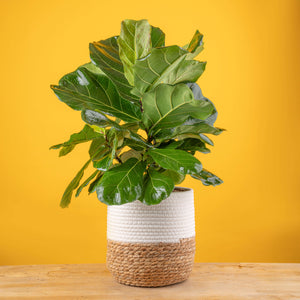Plant Care: Fiddle Leaf Fig (ficus lyrata)
How to care for a fiddle leaf fig (ficus lyrata) houseplant.
The fiddle leaf fig (Ficus lyrata) is one of the most popular and recognizable houseplants, known for its large, glossy violin-shaped leaves. While it has a reputation for being a bit finicky, it can thrive indoors with the right care—especially when you get the watering and light just right.

It is Important to Know Your Pot Size: 6-inch or 10-inch
Costa Farms Fiddle leaf figs are sold in either a 6-inch or a 10-inch pot. The pot size will influence how often and how much you need to water, how quickly the plant grows, and how long it can go between care tasks.
-
With a 6-inch pot give it one cup of room temperature water on watering day.
-
With a 10-inch pot give it 3 cups of room temperature water on watering day.
Regardless of size, your watering habits should be based on soil moisture, not just the calendar. Fiddle leaf figs need the soil to go dry about halfway down the pot.
Watering Your Fiddle Leaf Fig
Fiddle leaf figs don’t like to stay wet, but they don’t want to completely dry out either. The key is consistency and attentiveness.
When to Water:
Let the top 50% of the soil dry out between waterings: An old-fashion way to check the soil moisture is to use a wooden toothpick, barbeque kabob or a wooden chopstick or similar that you slide down into the soil about halfway down the pot. When you pull out the stick if it is clean, it means the soil is dry and you should water but if soil is attached to the stick it means the soil has moisture and you should wait.
General guideline:
-
Winter: About once every 3 weeks for plants in 10-inch pots. Every two weeks for 6-inch pots.
-
Spring/Summer: About once every 2 weeks for plants in 10-inch pots. Every 7 days for 6-inch pots.
Always check the soil first—don’t rely only on the calendar.
How to Water:
-
Use about 1 cup of lukewarm water for a 6-inch pot and 3 cups for a 10-inch pot.
-
Pour water evenly across the entire soil surface, not just in one spot. You want to make sure all of the roots are getting watered.
-
Avoid wetting the leaves—direct water onto the soil only.
🚫 Never Let It Sit in Water:
-
If your plant is in a decorative pot, make sure to empty any excess water from the bottom tray or outer pot about 20 minutes after watering.
-
Moist soil is good, but soggy soil will lead to root rot.
Light Requirements
Fiddle leaf figs thrive in bright, indirect light. A spot near a sunny window—such as an east-facing or north-facing window—is ideal.
-
Avoid direct sun, especially harsh afternoon light, which can scorch the leaves. Morning sun exposure until about 10 am is just fine.
-
Not enough light will cause slow growth, leaf drop, or stretching toward the window.
Tip: Rotate the plant every couple of weeks so it grows evenly and doesn’t lean in one direction.
Fertilizing
Feed your fiddle leaf fig in spring and summer only, when it's actively growing. Use a time-release fertilizer pellet formulated for houseplants. Apply once a month according to package instructions.
Avoid fertilizing in fall or winter, when growth slows and the plant is resting.
Temperature & Humidity
This is a tropical plant, so it prefers warmth and a bit of humidity.
-
Keep temperatures above 60 for healthy growth.
-
It can survive down to 55, but growth will slow, and the plant may suffer.
-
Avoid cold drafts, AC vents, or sudden temperature changes as they will stress the plant and can cause leaf drops.
-
If your home is dry (especially in winter), consider using a humidifier or placing the pot on a tray with pebbles and water to gently raise humidity.
Leaf Drop and Yellowing: What to Watch For
It’s normal for fiddle leaf figs to drop the occasional lower leaf as they grow. However:
-
Brown spots surrounded by yellowing generally indicates overwatering or poor drainage.
-
Dry edges or crispy leaves may signal underwatering or low humidity.
Repotting
If your fiddle leaf fig is thriving and growing fast, you may need to repot every 1–2 years, especially if:
-
Roots are coming out of the bottom of the pot.
-
Water runs through the soil too quickly.
-
Growth has slowed noticeably.
Move up just one pot size and use a high-quality, well-draining houseplant potting mix (a blend with coir/peat, perlite, and pine bark is ideal). Here are some helpful videos on repotting:
https://www.youtube.com/watch?v=aRCiKuzwG_0